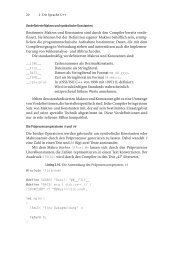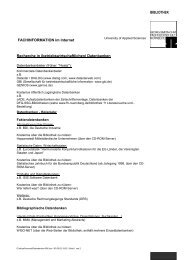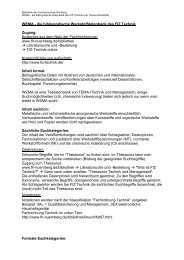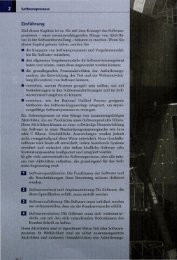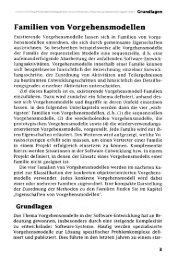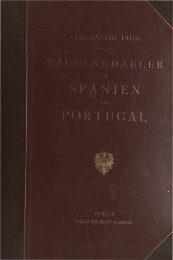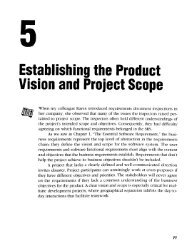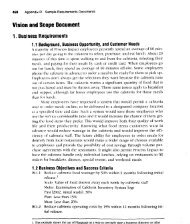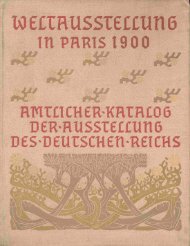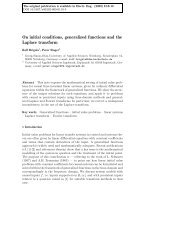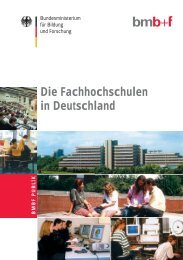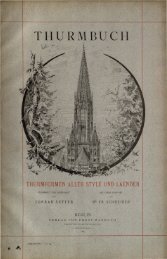essays - Georg-Simon-Ohm Hochschule Nürnberg
essays - Georg-Simon-Ohm Hochschule Nürnberg
essays - Georg-Simon-Ohm Hochschule Nürnberg
Create successful ePaper yourself
Turn your PDF publications into a flip-book with our unique Google optimized e-Paper software.
ESSAYS<br />
ON niE<br />
M I C R 0 S C 0 P E .. · "<br />
*
.<br />
XlV PREFA€E.<br />
Though all nature teems "\vith objects for . the microscopic<br />
observer, yet such is the indolence of the human mind, or such<br />
its inattention to what is obvious, that among the purchasers of<br />
microscopes many have complained that they knew not what<br />
subjects t'o apply to their instrument, or where to find objects for<br />
examination. To obviate this complaint, a catalogue is here<br />
given, which is interspersed with the description of a few insects,<br />
and other objects, which could not be conveniently introduced in<br />
the foregoing chapters. By this . catalogue it is hoped that the<br />
use of the microscope will be extended, and the path of observation<br />
facilitated.<br />
To avoid the formal parade of quotation, and the fastidious<br />
charge of plagiarism, I have subjoined to this preface a list of the<br />
authors "rhich have been consulted. As my extracts were made<br />
at very distant periods:, it vvould have been impossible for me to<br />
recollect to whom I was indebted for every new fact or ingenious<br />
observation.<br />
The plates \Vcre drawn and engraved with a view to be folded<br />
up with the work; but as it is the opinion of many of my friends<br />
that they would, by this mean, be materially injured, I have been<br />
advised to have them stitched in strong blue paper, and leave it<br />
to the purchaser to dispose of them to his own mind.
A COKCISE HISTORY OF<br />
to establish an opinion of its merit \vith the rest of the world, anJ<br />
hand do-wn the name of the inventor to succeeding agcs. 1\Ien<br />
of great literary abilities are too apt to despise thc first da\vnings<br />
,, of invention, not considering that all real knowledge is progressive,<br />
and that vvhat they deem tri:fiing, may be the first and nccessary<br />
link to a new branch of science.<br />
/<br />
The tnicroscope extends the boundaries of the organs of vision;<br />
enables us to examine the structure of plants and animals; presents<br />
to the eye myriads of beings, of whose existence vve had before<br />
formed no idea; opens to the curious an exhaustless source of<br />
information and pleasure; and furnishes the philosopher with an<br />
unlimited field of investigation. "It leads," to use the words of an'<br />
ingenious vvriter, " to the discovery of a thousand wonders in the<br />
works of his hand, who created ourselves, as well as the objects<br />
of our admiration; it improves the faculties, exalts the comprehension,<br />
and multiplies the inlets to happiness; is a new source of<br />
praise to him, to whom all we pay is nothing of what we ovve;<br />
and, while it pleases the imagination with the unbouncled treasures<br />
it otfers to the view, it tends to make the whole life one:<br />
continued act of admiration."<br />
lt is not diffieult to :fix the period when the rnicroscope first<br />
began to be generally known, and_ was used for the pu.rpose of<br />
examining minute objects; for, th
.OF THE DOUBLE OR COMPOUND MICROSCOPE. 43<br />
Fig. 5. Plate I. and an eye glass F G. The object B 0 is placed a<br />
little further from the lens than its principal focal distance, so<br />
that the pencils of rays proceeding from the different points of<br />
the object through the lens, may converge to their respective foci,<br />
and form an inverted image of the object at Q P; "\-vhich image is<br />
viewed by the eye through the eye glass F G, which is so placed,<br />
that the image may be in its focus on one side, and the eye at thc<br />
same distance on the other. The rays of each pencil "\-vill be<br />
parallel, after passing out of the glass, till they reach the eye at E,<br />
where they will begin to converge by the refractive powers of<br />
the humours; and after having crossed each other in the pupil,<br />
and passed through the crystalline and vitreous humours, they<br />
will be collected in points on the retina, and form a large inverted<br />
image thereon.<br />
It will be easy, from what has been already explained, to understand<br />
the reason of the magnifying power of a compoup.d<br />
l.Jlicroscope. The object is magnified upon two accounts; first,<br />
beea\l.Se if we viewed the image with the naked eye, it would<br />
appear as much larger than the object, as the image is really larger<br />
than it, or as the distance fR is greater than the distance fb;<br />
and secondly, because this picturc is again magnified by the eye<br />
glass, upon thc principlc explaincd in the foregoing article on<br />
vision, by single microscopcs.<br />
But it is to be noted, that the image formed in the focus of a<br />
lens, as is the case in the compound microscope, di:ffers from the<br />
real object in a very essential particular; that is- to say, the light<br />
being emitted from the object in every direction, renders it visible'<br />
to an eye placed in any position; but the points of the image<br />
formed by a lens, emitting no more than a small conical body of<br />
rays, which arrives from the glass, can be visible only when the<br />
eye is situate within its confine. Thus the pencil, which ema-<br />
F 2<br />
.,
APPARATUS 'l"O THE LUCERNAL MICROSCOPE. 70<br />
A pair of forceps, Fig. g, by which any occasional small object<br />
may be conveniently taken up.<br />
Six large ivory sliders, vvith transparent objects placed between<br />
two plates of talc, ancl con:fi.ned by brass rings, and six small ditto<br />
with ditto. }'ig. 10. Thc larger oncs usually contain a set of<br />
CL1stancc' s :fine vegetable cuttings.<br />
Fourteen wood sliders, containing on each four opake objects,.<br />
and two spare sliders for occasional objects; all fitted to the<br />
cheeks k 1 of the stage. Fig. 11.<br />
Some capillary tubes, Fig. 12, to receive small :fish, and for<br />
-viewing small animalcula. They are to be placed between the<br />
two plates of the stage No. 7, Fig. 4.<br />
A small ivpry double box, containing spare plates of talc and<br />
brass rings, for replacing· any in the small ivory sliders, .when<br />
necessary.<br />
A single lens mounted in a tortoiseshell case, to exaniine minute<br />
objects previous to their being applied to the slidcrs.<br />
Opake objects are easily put on the spare sliders by a wetted<br />
:wafer; and, for good security, gum water may be added ..<br />
For the prices of the lucernal, as weil as all the other sorts of<br />
microscopes, see the list annexed to these Essays ...<br />
"
go<br />
'<br />
APPAHATVS TO CUFF S MICROSCOPE.<br />
p q is the stage or plate which carries the objects; it has a<br />
hole at the center n.<br />
G, a concave mirror, that may be turned in any dircction, to<br />
reflect the light of the candle, or the sky, upon the object.<br />
A LIST OF THE APPARATUS TO CUFF's DOUBLE-COSSTRUCTEO<br />
MICROSCOPE.*<br />
H, a convex lens,to collect the rays of light from the sun or a<br />
candle, and condense them on the object, or to magnify a flower<br />
or other large object placed upon the stage.<br />
L, a cylindrical tube, open at each side, with a concave silver<br />
speculum screwed to the lower end h.<br />
·p, the slider-holder; it consists of a cvlindrical tube, in which<br />
"' '<br />
an inner tube is forced upvvarcls by a spiral spring, it is used to<br />
receive an ivory slider K, \Vhich is to be slid between the plates<br />
h and i. The cylinder P fits the holen in the stage: the hollow<br />
partat k is designed to receive a glass tube N.<br />
R is a brass cone, to be put under the bottom of the cylinder<br />
P, to intercept occasionally some of the rays of light.<br />
S, a box containing a concave and a ftat glass, between which<br />
a smallliving insect may be confined; it is to be placed over the<br />
holen.<br />
* This microscope is made oftentimes with a joint at the bottarn of the main pillar at e, "to<br />
admit placing the instrument into any oblique situation, and connected to the bottom of a<br />
mahogany ehest; on which account" it is by some of the instrument makers ca.lled the Chest<br />
Compound Mtcroscope. EDIT.
[ go ]<br />
LIST OF APPARATUS GENERALLY MADE TO TIIIS 1\IICROSCOPE.<br />
The wheel, with the magnifi.ers, P. Fig. 1.<br />
The body ofthe ,microscope, AB.<br />
'The slider-holder, K.<br />
The tube, with the condensing lens L, to be used by candlelight.<br />
The pin and arm a, either for the above lens, or for the silver<br />
concave speculum e.<br />
The silver concave speculum e, fitted to the arm above, and<br />
used common to all the magnifiers in the wheel and body AB, it<br />
is to reflect the light from the concave or plane mirror 0 belo·w,<br />
upon the opake objects, then called the compound opake microscope.<br />
A silver concave speculum f, with a single magnifier; it scre,vs<br />
to the under part of the arm CD in room of the wheel of magnifi.ers,<br />
and forins then the singleopake microscope.<br />
-<br />
A brass cone g, to place under the stage NI 8, and serves to<br />
diminish the reflected light wheri necessary.<br />
The jointed nippers b, fitted to the stage, to hold any small insect,<br />
or other .opake object.<br />
A cylinder of ivory h, to fix on the pointed end of the nippers, ·<br />
black on one side and white on the other, to make a cantrast to<br />
the opake object uscd.
AND PRESERVJNG TIIE POLYPES. l!i5<br />
Heat and cold has the same effect upon thesc littlc crcatures,<br />
that it has upon those of a larger size. 'They arc animatcd and<br />
enlivened by heat, ·whereas cold renders them faint and languid;<br />
they should therefore be kept in such a degree of heat, that the<br />
water may not bc below temperate.<br />
It is convenient for many cxperiments to suspend a polype<br />
from the surface of the w-ater. To cficct this, takc a hair pencil<br />
in one hand, and hold a pointed quill in the other; with the pencil<br />
loosen the ·polype fro'm the receiver in which it is kept, and<br />
gradually raise it near the top of the "\Vater, so that thc antcrior<br />
end may be next the point of the pencil; then lift it out of the<br />
water, and keep it so for a minute; after which, thrust the point<br />
of the pencil, togethcr with the antcrior end, by little and littlc<br />
under water, until no morc than about the twentieth part of an<br />
inch of the polype's tail re11.1.ains above its surface; at this instant,<br />
with the pointed quill remove that part of the polype from the<br />
pencil \vhich is already in the water, at the same time blowing<br />
against the pol:,ype, by which it will be loosened, and remain out<br />
of the water.<br />
\Vhcn the polypes wcre first uiscovered, l'1fr. Trembley had<br />
some difficulty to firHl out the food which was proper for them;<br />
but he soon discovercd, that a small species of thc milleperle
. TO OBTAIN THE PARTS OF A SIIOOT SEPARATE. l5!J<br />
" Trcatise on the Construction of Timbcr," what he has said;<br />
this, together with the improvements I have made on thc cutting<br />
engine, will enable the rcader to pursue thc subject and extend<br />
it further, both for his own pleasure, and the advantage of thc<br />
pu....:lic.<br />
TUE l\1AXNEP.. OF OBTAI)IflNG TUE PARTSOFA SHOOT<br />
SEPARATE.<br />
In the beginning of April, take a quantity of young branches<br />
from the scarlet oak, and other trees. These are first cut into<br />
lengths, of the growth of different seasons; and thcn part is lcft<br />
entire, part split, and the rest quartered. In this state they are<br />
put into a wicker basket, with large openings, or of loosc 'vork,<br />
and a heavy stone is put in with them; a rope is tied to the handle<br />
of the basket, and it is thrown into a brook of running water:<br />
at times it is taken llp, and exposed a little to the air; it is frcquently<br />
shook about under water, to wash off :61th; and once in<br />
ten days the sticks are examined.<br />
By degrees the parts loosen from one another,. and by gen'tie<br />
ruhhing in a bason of "\Vater just warmed, they ·will be so far<br />
separated, that a pencil brush ·will perfect the business, and afford<br />
pieccs of various sizes, pure, distinct, and clean. One part will<br />
in this way separate at one time, and another, at another; but<br />
by turning the sticks to the water,· ancl · repeating the operation,<br />
in the course of four or :five weeks every part may be obtained<br />
distinct. They are best examincd immediately;, but if any one<br />
wish to preserve them for repeated inquiries, it may be donein<br />
this manner: dissolve half an ounce of alum in two ,quarts of<br />
water; drop the pieces thus separated, for a fcw moments, into<br />
this solution, then dry them upon paper, and put them up in<br />
vials of spirit of wine, no other fluid being so well. adapted to,<br />
preserve these tender bodies.
[ lÖO ]<br />
TO PREPARE THE RIND FOR OBSERVATION.<br />
As the vessels of thc rind are of different diamcters in Yarious<br />
trees, though their construction and that of the. blebs is pcrfcctly<br />
the same in all, it willbebest to choose for this purpose the rind<br />
of a tree wherein they are largest. The rind of the ash-leavcd<br />
maple is finely suited. A piece of this may be obtaincd of two<br />
inches long, and will very successfully answer thc intention.<br />
Such a piece being preparcd without alum or spirit, but dried<br />
from the water in which it · had been macerated, it is to be impregnated.<br />
with leacl in the following manner, to shew the apertures-<br />
by their colour.<br />
Dissolve one drachm of sugar of leadinan ounce and an half<br />
of water; filter this through paper, and pour it into a tea-cup.<br />
Clip o:tf a thin slice of ·what ·was thc lowcr end of the piece _ of<br />
rind as it grew on the tree, and plunge it near an inch deep into<br />
the liquor; keep it upright bet\vcen t\VO pieces of stick, so that<br />
one half or more may be above thc "\Yater; whclm a winc-and-<br />
, "'<br />
water glass over the tea-cup, and set the whole in a ·warm place.<br />
When it has stood two days, take it out, clip off all that part<br />
which was in the liquor, and "throw if away .<br />
.;<br />
. -<br />
, The circumstances here mentioned, trivial as they may seem,<br />
must be attended to = the operatlon will not succeed, even if the<br />
covering-glass be omittcd; it keeps a moist atmosphere about the<br />
rind, and makes its vessels supple.<br />
vVhile this is standing, put into a bason two Ounces of quick<br />
1ime, and an ounce of orpiment; pour upon them a pint and an<br />
half of boi1ing watcr; stir the v;rhole together, and ·when it has<br />
;,tood a day and a night, it will be :fit for use. This is the
I>ISTINGUISHING CRITERIA. OP INSECTS. 217<br />
5. That they do not respire air by the mouth, but that they<br />
inspire and exhale it by means of organs which are placed on<br />
the body.<br />
0. That they move the Ja ws from right to left, not up and<br />
down.<br />
7. That they have neither eye-lid nor pupil.<br />
To these we may also add, that the mechanism resulting from<br />
the LIFE of insects is not of so compound a nature as in animals<br />
of a larger size. They have less variety of organs, though some<br />
of thetn are more multiplied; and it is by the number and situation<br />
of these that their rank in the great scale of beings is to bc<br />
determined.<br />
These characters are often united in the same insect; there are,<br />
howe_ver, some species in which one or two ofthem are wanting.<br />
The student in entomology, vvho wishes to attain a proper<br />
knowledge of the science, and indeed evcry microscopic observer,<br />
not so evident; Barbut, however, snpposes them to possess the sense of hearing in a very distinct<br />
mariner. Many insects, he observcs, are well lmown to be endued with the power of littering<br />
sounds, viz. large beetles, bees, wasps, common flies, gnats, &c. the sphinx atropos squeaks,<br />
· when hurt, nearly as loud as a mause: this faculty certainly must be intended for some purpose,<br />
and as they vaty their cry occasionally, it appears designed to give notice of pleasure or pain, or<br />
some. affection in the creature which possesses it. " The knowledge of their sounds," says he, .<br />
" is undoubtedly confined to their tribe, and is a language intelligible ta them only; saving when<br />
violence pbliges the animal to exert the _voice of nature in distress, craving compassion; then all<br />
animals understand the doleful cry; for instance, attack a bee or wasp near the hive or nest, or<br />
a few of them; the consequence will be, thc animal or animals, by a different toae of voice will<br />
e:x.press his or their disapprobation or pain; that sound is known to the hive to be pl'lintive, and ·<br />
that their brother or brethren require their assistance, and tlle offending party seldom escapes:<br />
, E e<br />
, /
DISTINGUISHING CRITERIA OF INSECTS. 219<br />
Specimens o( English Insects, drawn from Nature, by James<br />
Earbut.*<br />
Class the first. CoLEOPTERA. The insects of this dass have<br />
four wings; the upper ones, called the el ytra, are crustaceous,<br />
being of a hard horny substance; these, when shut, fonn a longitudinal<br />
suture down tbe back, as in the scarabreus, melolontha,<br />
or cockchaffer, &c.<br />
2. HEMIPTERA. These have also four wings; but the elytra<br />
are different, being half crustaceous, half membranaceous: thc<br />
\Yings do not form a longitudinal suture, but extend the one over<br />
the other, as in the gryllus, grasshopper, &c.<br />
3. LEPIDOPTERA. Those which have four membranaceaus<br />
wings covered with fine scales, appearing to the naked eye like<br />
powder or meal, as in the butterffy _and moth.<br />
4. NEUROP'.rERA. These have four membranaceous transparent<br />
wings, which aie generally reticulated, the tail without a<br />
sting, as in the libellula, or dragon fty.<br />
5. HYMENOPTERA. These, like the preceding dass, have four<br />
membranaceous naked wings; but the abdomen is furnished with<br />
a sting, as in the bee, wasp, ichneumon, &c.<br />
6. DIPTERA. These have only two wings, and are furnished<br />
with halteres, or poisers, instead· of under wings, as in the cammon<br />
hO«Se fly, gnat, &c.<br />
* This work contains two excellent plates, illustrative of the Distinctions of the Ordines and<br />
Genera Insectorum, by their antcnare, tarsi of the fcet; &c. EDIT. .<br />
•<br />
E e 2
230<br />
OF THE PUPA STATE OF INSECTS.<br />
proceeds as if it knew what would be the result of its operations.<br />
Difterent species prepare themselves for the change different ways,<br />
suited to their nature and the length of time they are to remain<br />
in this state.<br />
'Vhen the caterpillar has attained to its full growth, and the<br />
parts of'the -future butterfly are sufficiently formed beneath its<br />
skin, it prepares for its change into the pupa state; it seeks for a<br />
proper place in which to perform the important business: the<br />
different methods employed by these little animals to secure this<br />
state of rest, may be reduced to four:- 1. Some spin webs or<br />
cones, in which they inclose themselves. 2. Others conceal<br />
themselves in little cells, which they form under ground. 3. Some<br />
suspend themsclves by their posterior extremity; 4. 'Vhile others<br />
are suspended by a girdle that goes round their body. I shall<br />
describe the variety in these, as ·weil as the industry used in constructing<br />
them, after we have gone through the manner in which<br />
the caterpillar prepares itself for, and passes through the pupa<br />
state.<br />
Preparatory to the change, it ceases to take any food, empties<br />
itself of all the excrementitious matter that is contained in the<br />
intestines, voiding at the same time the. membrane which served<br />
as a lining to these . and the stomach. The intestinal canal is<br />
composed of two principal tubes; the one iriserted into the othcr;<br />
the external tube is compact and fleshy, the internal one is thin<br />
and transparent; it is the inner tube, which lines the stomach<br />
ancl intestiues, that is voicled with the excrement before the<br />
cbange. It generaU y perseveres in a state of rest and inactivity<br />
for several days, "\Yhich affords the external and internal organs.<br />
that alie under the skin an opportunity of gradually unfolding<br />
thcmsclvcs. In proportion as the change into the pupa form approaches,<br />
the bod,y js observed often to extend and contract it-
OF THE Il\1AGO OU FLY STATE OF INSECTS, 23{)<br />
scrved. Onc of thc most remarkable circumstances is, that the<br />
circulation of this fluid in the moth is dircctly contrary to that<br />
which took place in the caterpillar; in this, thc liquo1& move{l<br />
_from the tail to tbe head, 'Yhereas in the moth, it moves from the<br />
head to the tail; so that the fluid which answers the purposcs of<br />
the blood in the moth, goes from thc superior, towards the i'nferior<br />
parts, but in the voracious sensual caterpillar, the order is<br />
invertcd, it proceeds from the inferior towards the superior parts;<br />
all its members, formerly soft, inactive, and folded up under an<br />
envelope, are expanded, strengthened, and exposcd to observa!"<br />
tion.<br />
The food of the caterpillar is gross ancl solid, and cven this it<br />
is obliged to earn with much labour and danger; but, when freed<br />
as it were from the jaws of death, and arrived at its perfect form,<br />
the purest nectar is its potion, and the air its element. lt was<br />
su pplied with coarse food, in the :first state, by the painful opera ..<br />
tion of its teeth, which was afterwards digested by a violent trituration<br />
of the stomach. The intestines are now formed in a<br />
more delicate manner, and suited to a more pure MJ.d elegant<br />
aliment, which nature has prepared for its use from· the most<br />
fragrant and beautiful fiowers. J\lany internal parts of the cater<br />
:pillar disappear in the chrysalis, and many that could not be pereeived<br />
before, are now rendered visible: the interior changes are<br />
"not less surprizing than those of the exterior form, · and are, properly<br />
speaking, creative of them; for it is from these the exterior ·<br />
-form originates, and with these it always corresponds. In a word,<br />
the creature that heretofore crept upon the earth, now ß.ies freely<br />
through the air; and far fronl creating our aversion by its frightful<br />
prickles and foul appearance, it attracts our notice by the most<br />
elegant shape and apparel, and, from being scarce able to move .<br />
from one shrub to_ another, acquires strength and agility to tower;<br />
far above·the tallest inhabitant ·of the forest.
OF 'rHE GENERATION OF 'tNSECTS. 271<br />
gated, • enabling one single individual to give birth to thousands,<br />
or even millians of individuals like itself; all formed agreeablc to<br />
proportians which are only known to that ADORAJ1L.E "\VISDOM<br />
which hat; estaolished them. · 'V e shall never be able to form any<br />
adequate conoeption of this l)ower, till we are acquainted with<br />
the principles of life, and can trace their various gradations in<br />
different orders of beings. l\Iany ancient philosophers, from a<br />
misconception and perversion of the sentiments of the more an·<br />
cient sages, imagined that insects were produced from corrupt<br />
and putrefied substances; that organized bodies, animated with<br />
life, and framed in a most wonderful manner, owed their origin<br />
to mere chance! Not so the most ancient sages; they taught that<br />
every degree of life must proceed from the fountain and source of<br />
all life, and that therefore, '\Vhen manifested, it must be replete<br />
with infinite wonders; but then they also shewed, that if in its<br />
descent through the higher ()rders of being it was perverted, it<br />
would be manifested in ]oathsoine forms, and wit:h filthy propen·<br />
sities; and that accgrding to the degree of reception of the Divine·<br />
Goodness and Truth, or the perversion thereof, new forms of life<br />
would be occasionally manifested. The gloom of night still<br />
wraps this'subject in obscurity; will the dawn of day ere long<br />
gild the horizon of the scientific world? or is the time of its<br />
breaking forth yet far from us? Ee this as it may, insects will be<br />
found to conform tothat generallaw of order which runs through<br />
the whoJe of animated nature, namely, that the conjunction of<br />
the male and female is necessary for the production of their offspring.<br />
WheFe we cannot ascertain causes, we must be content<br />
with facts ..<br />
• Though insects are, like larger animals, distinguished into male<br />
and female, yet in some classes there is a kind of mules, partaking<br />
of neither sex, though themselves originating from the conjunc ...<br />
tion of both: many other particularities relative to the sexes calli<br />
•
•<br />
QP 'l'HE APHIDES. 277<br />
ceed one another in the interval. One is produced in I\Iay, which<br />
casts otf its covering; while the months of June and July each<br />
supply two more, which cast otf their coverings three or four<br />
tirnes, according to the different warmth of the season. This frequent<br />
change of their outward coat is thc more extraordinary, because<br />
it is repeated rnore often when thc insects corne the soonest<br />
to their growth, which sometimes happens in ten days, where<br />
warmth and plenty of nourishment conspirccl.<br />
Early in the month of June, some of the third generation, which<br />
were procluced about the rniddle of lVIay, after casting off their<br />
last covering, discover four erect wings, much longer than their<br />
bodies; and the sarne is obsvrvable in all the succeeding generations<br />
which are produced during the summer months, but still<br />
without any diversity of sex; for some time before the aphides<br />
come to their full growth, it is easy to distinguish which will have<br />
wings, by a remarkable fullness of the breast, which in the others<br />
is hardly tobe disfinguished from the body. When the last covering<br />
is rejected, 'the wings, which were before folded up in a<br />
very narrow compass, are gradually extended in 0 a surprizing<br />
manner, till their dimensions are at last very considerable.<br />
The increase of these insects in the summer time is so very<br />
great, that by wounding and exhausting the tender shoots, they<br />
0<br />
would frequently suppress all vegetation, had they not many<br />
euernies to restrain them. Notwithstanding these insects have a<br />
numerous tribe of eneinies, they are not without friends, if those<br />
may be considered as such, who are officious in their attendance<br />
for the good things they expect to reap thereby. The ant and<br />
the bee are of this kind, collecting thc honey in' which the aphides<br />
abound, but with this difference, that the ants are constant<br />
visitors, tbe bee only when flowers are scarce; the ants will suck
PHALlEN A COSSUS. 337<br />
first the word DIVISION is annexed. .The several parts exhibited<br />
in the divisions, Fig. 1, are the musdes; those in. Fig. 2, undr.r<br />
the word ring, are also musdes, which appear when those in<br />
Fig. 1 are removed, 1 ying under them.<br />
The anatomical delineation of the musdes of the head, Fig. 5<br />
and 6, should be considered as consisting of two figures, which<br />
join in the middle, being terminated by the superior and inferior<br />
lines. The head, _as here represented, is magnified about threehundred<br />
times. H H are the two palpi: the truncated musdes d,<br />
belong to the lower lip, and form a part of those which give it<br />
.motion: K, the two ganglions of the neck united: I I, the two<br />
silk vessels: L, the oesophagus:. M, the two dissolving vessels: the<br />
Hebrew letters denote the continuation of the cephalic arteries:<br />
s T u w and x are the · ten abductor musdes qf the ja w: und er e e<br />
and ff aie seen four 'occipital .mi.tsdes: a a, a nerve of the first<br />
pair, belanging to the ganglion of the neck; b, a branch of this<br />
nerve.<br />
Fig. 7 is an outliJile of the head magnified considerabl y more than<br />
in the last figure, exhibiting the nerves as seen from the under part.<br />
Excepting in two or three instances, only one nerve of each<br />
pair is shewn, as a greater number would have occasioned confusion.<br />
The nerves of the first ganglion of the neck are designcd<br />
by capital letters; those of the ganglion a, are distinguished by<br />
Roman;letters; those of the small ganglion, by Greek characters;<br />
and those of the frontal ganglion, except one, by numbers.<br />
A GENERAL VIEW OF THE INTERIOR PARTS OF THE<br />
CATERPILL-AR.<br />
\<br />
The MUSCLES have neither the exterior form, nor the colour<br />
of those of larger animals. In their natural state they are soft,<br />
u .u
414<br />
TUBULARIA CAMPANULATA.<br />
daily, and oftlieseoval bodies new animals are produced, exactly<br />
similar to the parent.<br />
· If. these minute bodies be eggs, they are of a singular kind,<br />
being destitute of any covering, and are neither mem branaceous<br />
nor ernstaceaus; we cannot with propriety say the young ones<br />
are hatched from them; we can, however, perceive these oviform<br />
bodies to unfold themselves gradually. The developement is<br />
accomplished in a few minutes, and an animalculum appears like<br />
the parent.<br />
Trembley amassed a great number of these eggs, and carried<br />
them from England with him:, keeping them quite dry; on putting<br />
them into water, they gradually developed, and became as<br />
perfect as the tubularia from which they proceeded.<br />
There is a very great similarity in the construction of this little<br />
creature and many of the marine polypes, who, like it, exist in<br />
tubes of the same growth with themselves.<br />
Fig. 32 represents three tubularire campanulatre or plumed polypes<br />
very much magnifi.ed, namely, one, hfacddehgi, which<br />
is o:ut.of its cell; eh, the oesophagus; fg, the stomach; af, the<br />
rectum; ac dde, the plurne, consisting of the base ,a e,· which is<br />
but little seen, · and the arms c d d, which proceed from the edges<br />
of this base; a second polype, AB I, which is within its cell, and·<br />
in which the skin containing the plume is reversed. The third<br />
polype, s tu u, is a young one exhibited out of its cell; g o o,<br />
threads which are fixed at one end to the intestines of the anima1,<br />
by the other to the bottom of the cell, 1 k. -
[ 415 ]<br />
C HA P. VIII.<br />
OF THE ANIMALCULA INFUSORIA.<br />
ÜUR knowledge of. the microscopic world is at present very<br />
contracted, but we know enough to give us high conceptions of<br />
its concealed wonders, and to iill us with profound astonishment<br />
at the mftnite virlety ofrf()T.ÜJS;tha.t'are :made recipient of life ..<br />
A few of the inhabitants oftbis :tninute world have been discovered.<br />
The figure and apparent habits of life of these, resemble.<br />
so little those with which we are tp.ore acquainted, that it is<br />
often difficult to find terms to express what is represented. to the<br />
eye.·<br />
Animalculum signifies a little animal, and therefore the term<br />
might be applied to every animal which is considerably inferior<br />
in size to ourselves. It has been customary, however, to distinguish<br />
by tne name of animalcula only such animals as are of a<br />
size so diminutive, that their true :figure cannot be discerned<br />
without the assistance of glasses; and more especially it ·is applied<br />
to such as are altogether invisible to the naked eye, and can-not<br />
even be perceived to exist, but by the aid of microscopes.<br />
B y the hel p of magnifying glasses we are brought into a kindl<br />
Qf new world; and numberless animals are discovercd, which,,
A METHODICAL DIVISION<br />
reasonably conclude that it is from hence that the little eels issue<br />
from the parent.<br />
In the latter part of the year, and during the ·winter, tl1ese eel"<br />
are oviparous, and the young eels may be seen to proceed from<br />
the egg; at other times they are viviparous; six live eels have<br />
been seen at one time in the belly of the parent, twenty-tw6<br />
eggs have been counted in the ovary. ]\-füller suspected fhat<br />
there was a difference of ,sex in some of these animalcula, but it<br />
was left to M. Roffredi to afford the proof, and it was
•<br />
OF THE ANIMALCULA INFUSORIA.<br />
This animalculum is long, more convex than most of the gcnus,<br />
divided by a kind of articulation into two parts equal in brea.dth,<br />
but of different lengths, the fore-part being shortcr than the hindpart;<br />
the apex furnished with short waving hair, indistinct rnole-'<br />
cules withinside, no hair on the hind-part .<br />
.<br />
217. TRICHODA LINTER. T. ovato oblonga, utraquc cxtrcmitate<br />
prominula. Plate XXV. Fjg. 51. The shape of an oblong<br />
egg, with prominences at both extremities.<br />
Both extremities of the body are raised, so that the bottom bccomes<br />
convex, and the upper part clepressed like a boat. It varies<br />
in shape at different ages, and sometimes has a rotatory motion.<br />
It is foun,d in an infusion of old grass.<br />
' 218. TfttEr1lÖDA PAXILLus. T. linearis depressa, antice trun-.<br />
cata crihitaque, postice obtusa. Linear :Bat trichoda:, the fore-.<br />
part truncated and hairy, the hinder-part obtuse.<br />
A long animalculum, full of grey molecules; the fore-part ra, ...<br />
ther smaller than the hind-part, and furnished with minute hairs.<br />
It was found in salt water.<br />
21Q. TRIGHODA. V ERMICULA.RIS. T. elongata, cylindracea,<br />
collo brevi, apice cri!lito. Plate XXVII .. Fig. 1.. Long cylindrical<br />
trichoda, with a short neck, the apex. hairy .<br />
•<br />
Gelatinous, the fore-part pellucid;the hind-part full of molecules.<br />
It was found in river water. It is represented in different<br />
appearances it;l. the ':fi.gure; a, the neck; b, the bairs; c, a<br />
little vesicle in the hin'der.:part.
A DESCRIPTION OF MINUTE SHELLS. 033<br />
or ornanient, or to the satisfying any appetite: neverthcless, a<br />
much nobler idea wrill take its rise in our opinion; one which, by<br />
displaying so momentously the power of the omniscient Creator,<br />
wi-ll thwart the infidel in his favourite ideas of escaping the eyes<br />
of the Almighty, and force him, as he descends the .scale from the<br />
moreimmense objects to these minutissima, to confess, that the<br />
being vvhich has formed these, can fully equal all that the tongue<br />
of man has yet declared of the possibility of his power. For,<br />
what a train of wonders have we here to pursue? 'Yhat must be<br />
the reconomy of animals so very diminutive, so weak, so exposed<br />
from their situation to the force of every rude wave, and who,<br />
not\.vithstanding, so often escape unhurt? How do they rear their<br />
young? From whence collect their prey ?"<br />
A. DE$CRIPTION AND ARRANGEMENT OF MINUTE AND<br />
RARE SHELLS.*<br />
SERPULA.<br />
TllE WORM-SHELL.<br />
SERPULA BicoRNIS. Plate XIV. Fig. 2. S. bicornis ventricosa.<br />
The bellied semilunar worm-shell.<br />
The 'colour white, opake, and glossy. From Sand wich and<br />
Reculver; though not common.<br />
SERPULA PERFORA TA. Fig. 3. S. bicornis umbilico perforato.<br />
The semilunar perforated worm-shell.<br />
* Being possessed of Mr. Jacoo's own corrected copy of the work, to which he has annexed<br />
the trivial names. I am thereby enabled to affix them to the several shells here enumerated.<br />
I<br />
4 L
08.02.2011<br />
HINWEIS<br />
Dieser Band wurde an der Hochschulbibliothek der <strong>Georg</strong>-<strong>Simon</strong>-<strong>Ohm</strong>-<strong>Hochschule</strong> <strong>Nürnberg</strong> eingescannt (Auflösung:<br />
300 dpi). Das Original stammt aus den historischen Altbeständen der Bibliothek.<br />
Signatur: 901/4.14773 / 2 a<br />
This volume was scanned at the University of Applied Sciences Library Nuremberg<br />
(resolution: 300 dpi).The original is part of the historic collection of the library.<br />
Book number: 901/4.14773 / 2 a<br />
http://www.ohm-hochschule.de/bibliothek<br />
<strong>Georg</strong>-<strong>Simon</strong>-<strong>Ohm</strong>-<strong>Hochschule</strong> für angewandte Wissenschaften<br />
Hochschulbibliothek<br />
Keßlerplatz 12<br />
90489 <strong>Nürnberg</strong>



